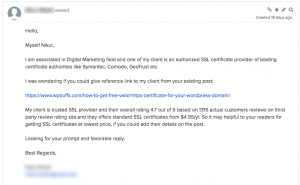— November 20, 2017

In the early days of the web, ranking in Google was easy – you just threw keywords in the meta description, and you ranked for those keywords, regardless of whether or not your website was relevant to them.
Nowadays, ranking well in the major search engines is a science – one that we know from a lot of trial and error, since Google and its competitors won’t ever tell us exactly how the ranking is achieved. Ultimately, the ranking algorithm is constantly being refined and learning from searchers’ behavior. Search engines get smarter every day, which means businesses that are ranking in the top spots of the results pages are doing better than ever… and businesses need to be trying harder to get as close to the top as possible. The more visible you are in the search engines, the more traffic you’re going to get. The more traffic you get, the more customers you can expect.
Step One: Find Your Core Keywords
After conducting the initial keyword research, find no less than five, but no more than 10 keywords that are most relevant to your business, with the highest search volume.
Step Two: Find Semantically Related Keywords
Now, go to the Google Keyword Planning Tool to find keywords that Google considers semantically related to those core keywords.
Step Three: Place Keywords in Buckets Based on Search Volume
Group the keywords into three buckets, and you’ll generally ended up with your head terns, body terms, and long tail terms. This gives you an idea of what kind of monthly search volume you can aim for if you’re able to rank your site in the top one to five spots. The number one spot in Google captures an average of 36% of clicks.
Step Four: Optimize Your Site from Tail to Head
Focus your attention first on the long tail keywords that are highly relevant to your business and give you the chance to build content for the larger and more competitive head terms. Generally speaking, the more words in a phrase, the lower the search volume, but the easier it is to rank for. Capturing the low-hanging fruit starts the conversions as soon as possible, because you’re targeting long tail terms in the short term, while building relevance and authority for the more competitive broader terms over the long term.
Step Five: Start Mining Data
Start with one of your core keywords, and look at the top 10 ranking websites. Use a scraping tool like SERPS Bookmarklet or SEOTools for Excel (Windows only) to collect the following data for each website:
- URL
- Domain Authority
- Page Authority
- Number of indexed links
- Number of linking root domains
Put all of this information in a spreadsheet for easier tracking. You can repeat these steps for the rest of your core keywords, adding the information to a new sheet in the workbook. This way, you’ll have it so you can track your ranking position over time in comparison to what the results were when you first started.
DA is an important thing to consider – the higher the number, the harder it will be to compete against. You can get there, but it will take time. DA comes with quality content, traffic, and domain age. If the top results have Das of 90+, and your DA is only 20 – don’t expect to land in the top 5 soon. This is a general rule – so it’s not impossible, but it’s not likely.
Step Six: Backlink Profile Analysis and BackLink Detox
Use a tool like Open Site Explorer or SEMRush’s Backlink Audit Tool to look at the types of links pointing to your competitors. Do this for each ranking URL. This lets you see how your competition is building their links, and whether or not they are using spam techniques to build out their link profiles. Here, you should be able to see how many links are broken, and how many links come from link lists or directories, which are not hard to beat in terms of authority. You also need a well thought out plan on removing your own toxic backlinks.
Step Seven: Developing Your Action Plan
With the data at hand, you can now identify opportunities to get more backlinks than your competition. Part of outranking someone lies in having more backlinks, but also better backlinks. Don’t just go buy 1,000 more links that what your competitor has. Focus on getting links from as many quality, high DA, relevant domains as possible… and determine how you’re going to do it. Maybe you’ll write guest posts. Maybe you’ll link to something useful on their site, and ask that they link to you. Maybe you approach the sites with broken links and ask them to replace those links with links to your resource that’s similar, if not better than the original. There are all kinds of things you can do to build links.
Digital & Social Articles on Business 2 Community
(59)









